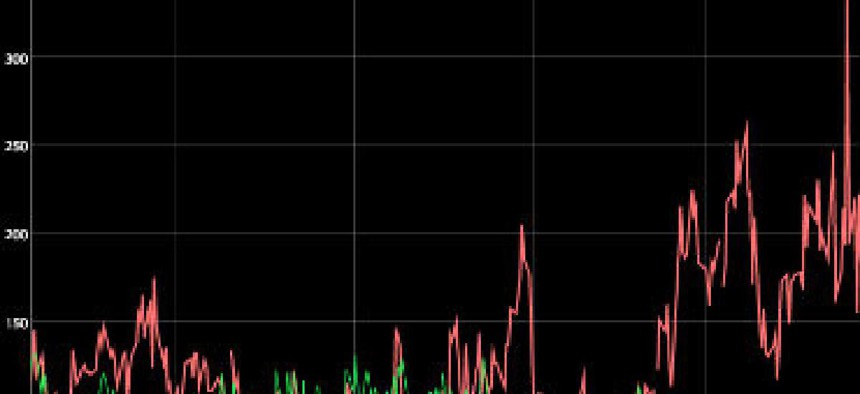SEC's MIDAS program highlights how to do big data

Rather than retroactively try to reconstruct the next market anomaly, the SEC launched the Market Information Data Analytics System, which collects more than one billion records per day.

The Market Information Data Analytics System gives Securities and Exchange Commission staff near-real-time access to market trading data -- and offers valuable analytics to outside users as well.
The Flash Crash of May 6, 2010, caused a five-minute panic on Wall Street -- and inadvertently drove what has become one of the most successful big data projects in government at the Securities and Exchange Commission.
Under the SEC's existing technologies, the crash itself -- a rapid 1,000-point plunge followed by a full recovery 15 minutes later -- took the SEC's investigatory unit approximately four months to reconstruct and analyze. That is an eternity in today's stock market, where trades are measured in microseconds. The report itself required an analysis of thousands of stocks' order book and complex analytics to analyze billions of records to reconstruct the crash's events.
During the painstaking work, Gregg Berman, associate director for the SEC's Office of Analytics and Research, said it became clear that the agency's use of market technologies needed a dramatic modernization. Nobody wanted to do that again.
"We knew we had to get a system," said Berman. "The very next thing we did after the report was begin to look at what we could do."
Rather than retroactively try to reconstruct the next market anomaly, the SEC launched a concerted effort to ensure it would never again lack for information.
The effort resulted in the January 2013 rollout of the Market Information Data Analytics System (MIDAS), which collects more than one billion records per day from each of the 13 national equity exchanges, each time-stamped to the microsecond. For the first time, the SEC had access to data about every displayed order posted in the national exchanges in near real-time.
According to Berman, who won a Federal 100 award for his work on the MIDAS project, it gives the SEC the horsepower to monitor market activities as they happen, and is invaluable in forensic analysis. It also provides valuable information to broader investigations conducted by other SEC components, and to its data serves to inform better policy decisions.
"There are many blips. There is always something interesting happening in the equity markets," Berman said.
Given its full-scale capabilities on rollout in early 2013, MIDAS probably justified its small-by-federal-standards cost of $2.5 million in year one. The SEC tasked Tradeworx, a financial technology company, to build MIDAS, and hosted the entire operation in an Amazon Web Services cloud.
Trade data comes from consolidated public and proprietary feeds and goes to the AWS public cloud, where it's fodder for advanced analytics and accessible through an SEC firewall by users on their desktop computers. From an IT perspective, the SEC's involvement is minimal, yet the vast data trove is accessed daily by a core group of SEC employees from various divisions for a variety of purposes.
But rather than simply collect and store data, the SEC added significant value to an already successful project by sharing its data through intuitive visualizations. The SEC's website, rolled out in October 2013, allows users with a bit of market knowledge to examine metrics and trends based on the data it has collected through MIDAS. The interactive charting tool, spearheaded by one of the SEC's core members, Laura Egerdal, allows users to visualize more than 600 market-structure metrics.
According to Egerdal, cramming all that data into a PDF file for a few occasional downloaders would be a waste of valuable information.
"Part of the reason I proposed visualizations was my sense, after learning all the things you could discover from this data, that just popping it in a PDF wasn't going to get it the attention it deserved," Egerdal said. "We want to be having a broader conversation."
In addition, various staff compiles research papers based on intriguing MIDAS information -- all of which are made available to the public. For lay people, complex trading data is not easy reading, but the site has attracted a slew of market gurus, tracking 80,000 hits in its first month.
"There is not a mandate for us to produce this, but the return is not just to the SEC but to market participants in us producing this information," Berman said.
MIDAS also helped the SEC comply with the Obama administration's push to make regulatory agencies more data-centric. By government standards, the SEC's MIDAS implementation was moderately quick: a request for information (RFI) in October 2010, an RFP in November 2011, a contract award in June 2012 and a January 2013 rollout. But the planning process was meticulous, with personnel shifting and development of the Office of Analytics and Research planned before data came pouring in.
"We did it in the opposite way everyone else would do it," Berman said. "Data-first is not the way. We wanted to know what questions we have to answer here and now and 10 years from now. That dictates the system you need to get, which dictates the data you need. This approach allowed us to be very specific in our RFP -- we knew exactly what we wanted and the style to engage.
Should another market anomaly like the Flash Crash of 2010 occur, MIDAS negates the need for the SEC to spend millions of dollars or thousands of man-hours determining what happened. Regardless, its careful development ensures that it will continue producing value to the agency and the public. This is of critical importance as federal agencies embark on large-scale projects that involve ever-growing datasets.
"The goal in government isn't to make a profit," Egerdal said. "But we can make value."
NEXT STORY: Don't call it derivative!






